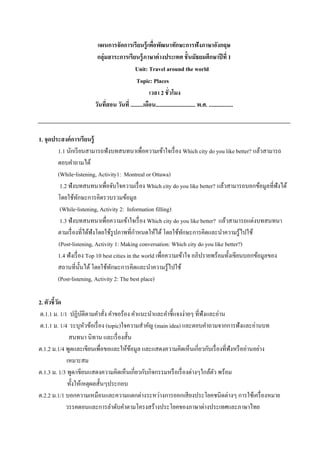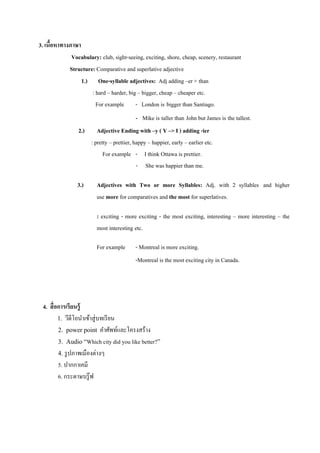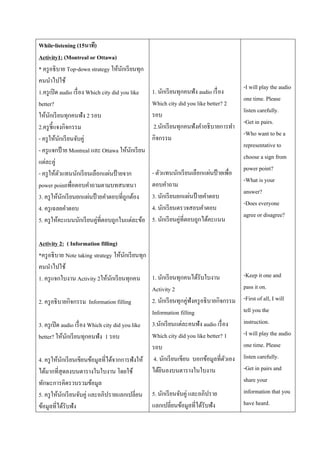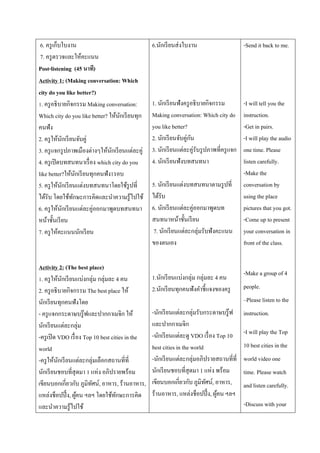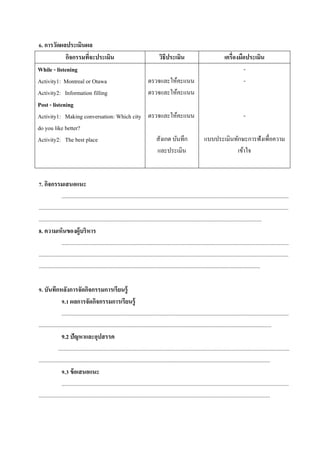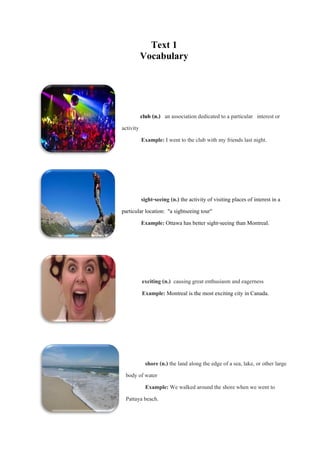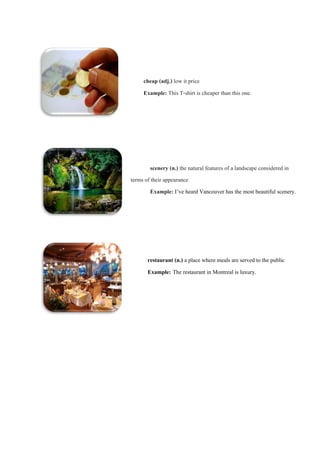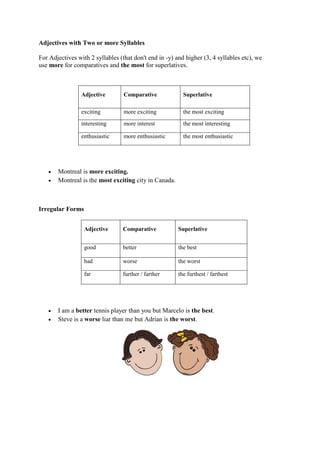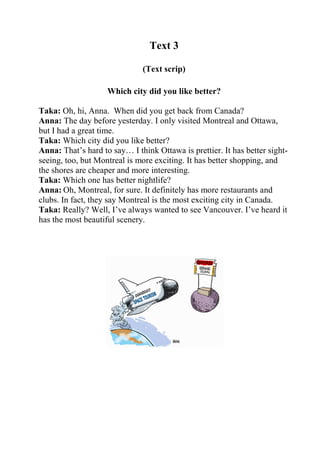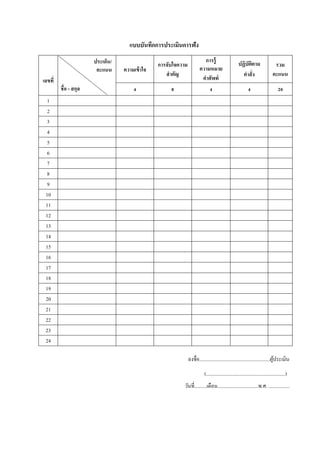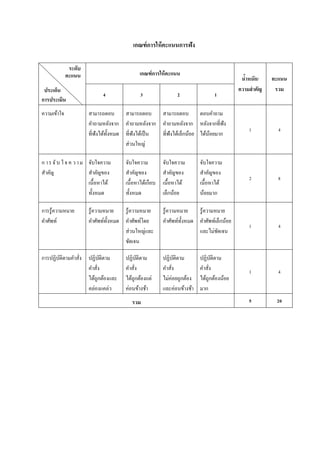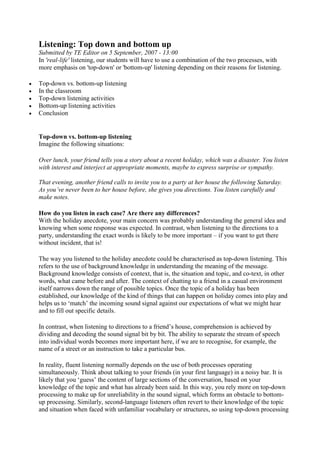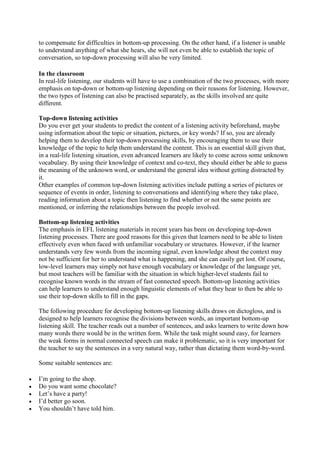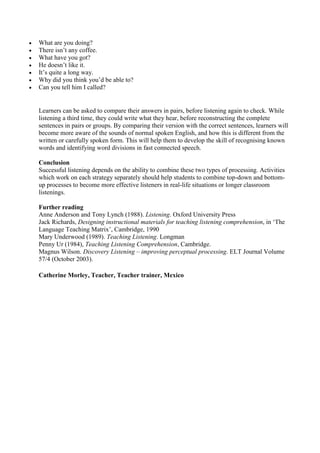а№Ғаёңаёҷ Listening аёЎ.1 аё„аёЈ аёҮаё—__3 аёң_аёІаёҷ
- 1. а№ҒаёңаёҷаёҒаёІаёЈаёҲаёұаё”аёҒаёІаёЈа№ҖаёЈаёөаёўаёҷаёЈаё№а№үа№Җаёһаё·аёӯаёһаёұаё’аёҷаёІаё—аёұаёҒаё©аё°аёҒаёІаёЈаёҹаёұаёҮаё аёІаё©аёІаёӯаёұаёҮаёҒаёӨаё© а№Ҳ аёҒаёҘаёёа№ҲаёЎаёӘаёІаёЈаё°аёҒаёІаёЈа№ҖаёЈаёөаёўаёҷаёЈаё№а№үаё аёІаё©аёІаё•а№Ҳ аёІаёҮаёӣаёЈаё°а№Җаё—аёЁ аёҠаёұа№үаёҷаёЎаёұаёҳаёўаёЎаёЁаё¶аёҒаё©аёІаёӣаёө аё—аёөа№Ҳ 1 Unit: Travel around the world Topic: Places аёӘаёЎаёІаёҠаёҙаёҒ 1. аёҷаёІаёҮаёӘаёІаё§аёҲаёұаёҷаёҲаёҙаёЈаёІ аёҲаёұаёҷаё—аёЈа№Ң а№Ӯаёһаёҳаёҙа№Ң 2. аёҷаёІаёҮаёӘаёІаё§аёҠไมаёһаёЈ а№ҖаёҠаё•аёёаёЈаёІаёҠ 3. аёҷаёІаёҮаёӘаёІаё§аё”аёІаёЈаёІаёһаёЈ аёЎаёёаёҘаё—аёІ 53010513013 53010513017 53010513023 аёҷаёҙаёӘаёҙаё•аёҠаёұа№үаёҷаёӣаёө аё—аёөа№Ҳ 4 аёӘаёІаёӮаёІаё аёІаё©аёІаёӯаёұаёҮаёҒаёӨаё© аёЈаё«аёұаёӘаё§аёҙаёҠаёІа№ҖаёӯаёҒ EN аёЈаё°аёҡаёҡаёӣаёҒаё•аёҙ аёҒаёҘаёёа№ҲаёЎа№ҖаёЈаёөаёўаёҷаё§аёұаёҷаёҲаёұаёҷаё—аёЈа№Ң а№Җаё§аёҘаёІ 09.00- 12.00 аёҷ. аёӘа№Ҳ аёҮаё„аёЈаёұа№үаёҮаё—аёөа№Ҳ 3 аё§аёұаёҷаё—аёөа№Ҳ 6 аёЎаёҙаё–аёёаёҷаёІаёўаёҷ 2556
- 2. а№ҒаёңаёҷаёҒаёІаёЈаёҲаёұаё”аёҒаёІаёЈа№ҖаёЈаёө аёўаёҷаёЈаё№а№ү а№Җаёһаё·аёӯаёһаёұаё’аёҷаёІаё—аёұаёҒаё©аё°аёҒаёІаёЈаёҹаёұаёҮаё аёІаё©аёІаёӯаёұаёҮаёҒаёӨаё© а№Ҳ аёҒаёҘаёёа№ҲаёЎаёӘаёІаёЈаё°аёҒаёІаёЈа№ҖаёЈаёөаёўаёҷаёЈаё№а№ү аё аёІаё©аёІаё•а№Ҳ аёІаёҮаёӣаёЈаё°а№Җаё—аёЁ аёҠаёұа№ү аёҷаёЎаёұаёҳаёўаёЎаёЁаё¶аёҒаё©аёІаёӣаёө аё—аёөа№Ҳ 1 Unit: Travel around the world Topic: Places а№Җаё§аёҘаёІ 2 аёҠаёұа№Ҳаё§а№ӮаёЎаёҮ аё§аёұаёҷаё—аёөаёӘаёӯаёҷ аё§аёұаёҷаё—аёөа№Ҳ .........а№Җаё”аё·аёӯаёҷ............................ аёһ.аёЁ. ................. а№Ҳ 1. аёҲаёёаё”аёӣаёЈаё°аёӘаёҮаё„а№Ң аёҒаёІаёЈа№ҖаёЈаёө аёўаёҷаёЈаё№а№ү 1.1 аёҷаёұаёҒа№ҖаёЈаёө аёўаёҷаёӘаёІаёЎаёІаёЈаё–аёҹаёұаёҮаёҡаё—аёӘаёҷаё—аёҷаёІа№Җаёһаё·а№Ҳаёӯаё„аё§аёІаёЎа№ҖаёӮа№үаёІа№ғаёҲа№ҖаёЈаё·а№Ҳ аёӯаёҮ Which city do you like better? а№ҒаёҘа№үаё§аёӘаёІаёЎаёІаёЈаё– аё•аёӯаёҡคาถามไดа№ү (While-listening, Activity1: Montreal or Ottawa) 1.2 аёҹаёұаёҮаёҡаё—аёӘаёҷаё—аёҷаёІа№Җаёһаё·а№ҲаёӯаёҲаёұаёҡа№ғаёҲаё„аё§аёІаёЎа№ҖаёЈаё·а№Ҳ аёӯаёҮ Which city do you like better? а№ҒаёҘа№үаё§аёӘаёІаёЎаёІаёЈаё–аёҡаёӯаёҒаёӮа№үаёӯаёЎаё№аёҘаё—аёөа№ҲаёҹаёұаёҮไดа№ү а№Ӯаё”аёўа№ғаёҠа№үаё—аёҒаё©аё°аёҒаёІаёЈаё„аёҙаё”аёЈаё§аёҡаёЈаё§аёЎаёӮа№үаёӯаёЎаё№аёҘ аёұ (While-listening, Activity 2: Information filling) 1.3 аёҹаёұаёҮаёҡаё—аёӘаёҷаё—аёҷаёІа№Җаёһаё·а№Ҳаёӯаё„аё§аёІаёЎа№ҖаёӮа№үаёІа№ғаёҲа№ҖаёЈаё·а№Ҳ аёӯаёҮ Which city do you like better? а№ҒаёҘа№үаё§аёӘаёІаёЎаёІаёЈаё–а№Ғаё•а№ҲаёҮаёҡаё—аёӘаёҷаё—аёҷаёІ аё•аёІаёЎа№ҖаёЈаё·а№Ҳ аёӯаёҮаё—аёөа№Ҳไดа№үаёҹаёұаёҮа№Ӯаё”аёўа№ғаёҠа№үаёЈаё№аёӣаё аёІаёһаё—аёөа№ҲаёҒаёІаё«аёҷаё”а№ғаё«а№үไดа№ү а№Ӯаё”аёўа№ғаёҠа№үаё—аёҒаё©аё°аёҒаёІаёЈаё„аёҙаё”а№ҒаёҘаё°аёҷаёІаё„аё§аёІаёЎаёЈаё№а№үไаёӣа№ғаёҠа№ү аёұ (Post-listening, Activity 1: Making conversation: Which city do you like better?) 1.4 аёҹаёұаёҮа№ҖаёЈаё·а№Ҳ аёӯаёҮ Top 10 best cities in the world а№Җаёһаё·а№Ҳаёӯаё„аё§аёІаёЎа№ҖаёӮа№үаёІа№ғаёҲ аёӯаё аёҙаёӣаёЈаёІаёўаёһаёЈа№үаёӯаёЎаё—аёұа№үаёҮа№ҖаёӮаёөаёўаёҷаёҡаёӯаёҒаёӮа№үаёӯаёЎаё№аёҘаёӮаёӯаёҮ аёӘаё–аёІаёҷаё—аёөа№Ҳаёҷа№ү аёҷไดа№ү а№Ӯаё”аёўа№ғаёҠа№үаё—аёҒаё©аё°аёҒаёІаёЈаё„аёҙаё”а№ҒаёҘаё°аёҷаёІаё„аё§аёІаёЎаёЈаё№а№үไаёӣа№ғаёҠа№ү аёұ аёұ (Post-listening, Activity 2: The best place) 2. аё•аёұаё§аёҠаёөа№үаё§аё” аёұ аё•.1.1 аёЎ. 1/1 аёӣаёҸаёҙаёҡаё•аёҙаё•аёІаёЎаё„аёІаёӘаёұаёҮ аё„аёІаёӮаёӯаёЈа№үаёӯаёҮ аё„аёІа№Ғаёҷаё°аёҷаёІа№ҒаёҘаё°аё„аёІаёҠаёөа№үа№ҒаёҲаёҮаёҮа№ҲаёІаёўа№Ҷ аё—аёөа№ҲаёҹаёұаёҮа№ҒаёҘаё°аёӯа№ҲаёІаёҷ аёұ а№Ҳ аё•.1.1 аёЎ. 1/4 аёЈаё°аёҡаёёаё«аё§аёӮа№үаёӯа№ҖаёЈаё·а№Ҳ аёӯаёҮ (topic)а№ғаёҲаё„аё§аёІаёЎаёӘаёІаё„аёұаёҚ (main idea) а№ҒаёҘаё°аё•аёӯаёҡаё„аёІаё–аёІаёЎаёҲаёІаёҒаёҒаёІаёЈаёҹаёұаёҮа№ҒаёҘаё°аёӯа№ҲаёІаёҷаёҡаё— аёұ аёӘаёҷаё—аёҷаёІ аёҷаёҙаё—аёІаёҷ а№ҒаёҘаё°а№ҖаёЈаё·а№Ҳ аёӯаёҮаёӘаёұа№үаёҷ аё•.1.2 аёЎ.1/4 аёһаё№аё”а№ҒаёҘаё°а№ҖаёӮаёөаёўаёҷа№Җаёһаё·а№ҲаёӯаёӮаёӯа№ҒаёҘаё°а№ғаё«а№үаёӮаёӯаёЎаё№аёҘ а№ҒаёҘаё°а№ҒаёӘаё”аёҮаё„аё§аёІаёЎаё„аёҙаё”а№Җаё«а№Үаёҷа№ҖаёҒаёөа№Ҳаёўаё§аёҒаёұаёҡа№ҖаёЈаё·а№Ҳ аёӯаёҮаё—аёөа№ҲаёҹаёұаёҮаё«аёЈаё· аёӯаёӯа№ҲаёІаёҷаёӯаёўа№ҲаёІаёҮ а№ү а№Җаё«аёЎаёІаё°аёӘаёЎ аё•.1.3 аёЎ. 1/3 аёһаё№аё”/а№ҖаёӮаёөаёўаёҷа№ҒаёӘаё”аёҮаё„аё§аёІаёЎаё„аёҙаё”а№Җаё«а№Үаёҷа№ҖаёҒаёөа№Ҳаёўаё§аёҒаёұаёҡаёҒаёҙаёҲаёҒаёЈаёЈаёЎаё«аёЈаё· аёӯа№ҖаёЈаё·а№Ҳ аёӯаёҮаё•а№ҲаёІаёҮа№Ҷа№ғаёҒаёҘа№үаё•аё§ аёһаёЈа№үаёӯаёЎ аёұ аё—аёұа№үаёҮа№ғаё«а№үа№Җаё«аё•аёёаёңаёҘаёӘаёұа№үаёҷа№ҶаёӣаёЈаё°аёҒаёӯаёҡ аё•.2.2 аёЎ.1/1 аёҡаёӯаёҒаё„аё§аёІаёЎа№Җаё«аёЎаё·аёӯаёҷа№ҒаёҘаё°аё„аё§аёІаёЎа№Ғаё•аёҒаё•а№ҲаёІаёҮаёЈаё°аё«аё§а№ҲаёІаёҮаёҒаёІаёЈаёӯаёӯаёҒа№ҖаёӘаёө аёўаёҮаёӣаёЈаё°а№Ӯаёўаё„аёҠаёҷаёҙаё”аё•а№ҲаёІаёҮа№Ҷ аёҒаёІаёЈа№ғаёҠа№үа№Җаё„аёЈаё·а№Ҳ аёӯаёҮаё«аёЎаёІаёў аё§аёЈаёЈаё„аё•аёӯаёҷа№ҒаёҘаё°аёҒаёІаёЈаёҘаёІаё”аёұаёҡаё„аёІаё•аёІаёЎа№Ӯаё„аёЈаёҮаёӘаёЈа№үаёІаёҮаёӣаёЈаё°а№Ӯаёўаё„аёӮаёӯаёҮаё аёІаё©аёІаё•а№ҲаёІаёҮаёӣаёЈаё°а№Җаё—аёЁа№ҒаёҘะภาษาไทย
- 3. 3. а№Җаёҷаё·аёӯаё«аёІаё—аёІаёҮаё аёІаё©аёІ а№ү Vocabulary: club, sight-seeing, exciting, shore, cheap, scenery, restaurant Structure: Comparative and superlative adjective 1.) One-syllable adjectives: Adj adding вҖ“er + than : hard вҖ“ harder, big вҖ“ bigger, cheap вҖ“ cheaper etc. For example - London is bigger than Santiago. Mike is taller than John but James is the tallest. 2.) Adjective Ending with вҖ“y ( Y вҖ“> I ) adding -ier : pretty вҖ“ prettier, happy вҖ“ happier, early вҖ“ earlier etc. For example - I think Ottawa is prettier. - She was happier than me. - 3.) Adjectives with Two or more Syllables: Adj. with 2 syllables and higher use more for comparatives and the most for superlatives. : exciting - more exciting - the most exciting, interesting вҖ“ more interesting вҖ“ the most interesting etc. For example - Montreal is more exciting. -Montreal is the most exciting city in Canada. 4. аёӘаё·а№Ҳ аёӯаёҒаёІаёЈа№ҖаёЈаёө аёўаёҷаёЈаё№а№ү 1. аё§аёөаё”аёөа№ӮаёӯаёҷаёІа№ҖаёӮа№үаёІаёӘаё№а№Ҳ аёҡаё—а№ҖаёЈаёө аёўаёҷ 2. power point аё„аёІаёЁаёұаёһаё—а№Ңа№ҒаёҘаё°а№Ӯаё„аёЈаёҮаёӘаёЈа№үаёІаёҮ 3. Audio вҖңWhich city did you like better?вҖқ 4. аёЈаё№ аёӣаё аёІаёһа№ҖаёЎаё·аёӯаёҮаё•а№ҲаёІаёҮа№Ҷ 5. аёӣаёІаёҒаёҒаёІа№Җаё„аёЎаёө 6. аёҒаёЈаё°аё”аёІаё©аёҡаёЈаё№а№Ҡ аёҹ
- 4. 5. аёҒаёҙаёҲаёҒаёЈаёЈаёЎаёҒаёІаёЈа№ҖаёЈаёө аёўаёҷаёЈаё№а№ү аё„аёЈаё№ Pre-listening (1 аёҠаёұа№Ҳаё§а№ӮаёЎаёҮ) 1.аё„аёЈаё№ а№ғаё«а№үаёҷаёҒа№ҖаёЈаёө аёўаёҷаё”аё№аё§аёөаё”аёөа№Ӯаёӯа№ҖаёЈаё·а№Ҳ аёӯаёҮTop 10 best cities аёұ in the world а№Җаёһаё·а№ҲаёӯаёҷаёІа№ҖаёӮа№үаёІаёӘаё№а№Ҳ аёҡаё—а№ҖаёЈаёө аёўаёҷ 2. аё„аёЈаё№ аё–аёІаёЎаё„аёІаё–аёІаёЎаёҲаёІаёҒаё§аёөаё”аёөа№Ӯаёӯ а№Ӯаё”аёўа№ғаёҠа№үаёӣаёЈаё°а№Ӯаёўаё„ аё„аёІаё–аёІаёЎ а№ҖаёҠа№Ҳаёҷ - What did you see from the VDO? - What the VDO show about? 3.аё„аёЈаё№ а№ҒаёҲаёҒ Text 1а№ғаё«а№үаёҷаёҒа№ҖаёЈаёө аёўаёҷаё—аёёаёҒаё„аёҷа№ҒаёҘа№үаё§а№Җаёӣаёҙ аё” аёұ Power point а№Ғаёҷаё°аёҷаёІаё„аёІаёЁаёұаёһаё—а№Ңа№ғаё«аёЎа№Ҳа№ғаё«а№үаёҷаёҒа№ҖаёЈаёө аёўаёҷаёҹаёұаёҮ аёұ а№ҒаёҘаё°аёӯаёӯаёҒа№ҖаёӘаёө аёўаёҮаё•аёІаёЎ аёһаёЈа№үаёӯаёЎаё—аёұа№үаёҮаёӯаёҳаёҙ аёҡаёІаёўаёҠаёҷаёҙаё” аёЈаё№ аёӣа№Ғаёҡаёҡ аё„аё§аёІаёЎаё«аёЎаёІаёўаёӮаёӯаёҮаё„аёІаёЁаёұаёһаё—а№Ңа№ҒаёҘаё°аёўаёҒаё•аёұаё§аёӯаёўа№ҲаёІаёҮ аёҒаёІаёЈаёҷาไаёӣа№ғаёҠа№ү 4. аё„аёЈаё№ аё•аёЈаё§аёҲаёӘаёӯаёҡаё„аё§аёІаёЎа№ҖаёӮа№үаёІа№ғаёҲаёӮаёӯаёҮаёҷаёұаёҒа№ҖаёЈаёө аёўаёҷа№Ӯаё”аёўа№ғаё«а№ү аёҷаёұаёҒа№ҖаёЈаёө аёўаёҷаёўаёҒаё•аёұаё§аёӯаёўа№ҲаёІаёҮаёӣаёЈаё°а№Ӯаёўаё„а№Ӯаё”аёўа№ғаёҠа№үаё„аёІаёЁаёұаёһаё—а№Ңаё—аёөа№Ҳไดа№ү а№ҖаёЈаёө аёўаёҷ 5. аё„аёЈаё№ а№ҒаёҲаёҒ Text 2 а№ҒаёҘа№үаё§аёӯаёҳаёҙаёҡаёІаёўаёҒаёІаёЈа№ғаёҠа№үаё«аёҘаёұаёҒ ไวยาаёҒаёЈаё“а№Ңа№ғаё«а№үаёҷаёҒа№ҖаёЈаёө аёўаёҷаёҹаёұаёҮаёһаёЈа№үаёӯаёЎаё—аёұа№үаёҮаёӯаёҳаёҙ аёҡаёІаёў аёұ аё«аёҘаёұаёҒа№ҖаёҒаё“аё‘а№Ңа№ҒаёҘаё°аёҒаёҺаёҒаёІаёЈаёҷาไаёӣа№ғаёҠа№ү 6. аё„аёЈаё№ а№Җаёӣаёҙ аё” audio а№ҖаёЈаё·а№Ҳ аёӯаёҮ Which city did you like better?а№ғаё«а№үаёҷаёҒа№ҖаёЈаёө аёўаёҷаёҹаёұаёҮ 2 аёЈаёӯаёҡ аёұ 7. аё„аёЈаё№ аё–аёІаёЎаёҷаёұаёҒа№ҖаёЈаёө аёўаёҷа№ҖаёҒаёөа№Ҳаёўаё§аёҒаёұаёҡа№ҖаёЈаё·а№Ҳ аёӯаёҮаё—аёөа№ҲаёҹаёұаёҮа№Җаёһаё·а№Ҳаёӯ аё•аёЈаё§аёҲаёӘаёӯаёҡаё„аё§аёІаёЎа№ҖаёӮа№үаёІа№ғаёҲаёӯаёөаёҒаё„аёЈаёұа№үаёҮ а№ҖаёҠа№Ҳаёҷ - When did Anna get back from Canada? - Where did Anna go to visit? - Where is the most exciting city in Canada? аёҷаёұаёҒа№ҖаёЈаёөаёўаёҷ Classroom language -First of all, I have a 1. аёҷаёұаёҒа№ҖаёЈаёө аёўаёҷаё”аё№аё§аё”аёөа№ӮаёӯаёҷаёІа№ҖаёӮа№үаёІаёӘаё№а№Ҳ аёҡаё—а№ҖаёЈаёө аёўаёҷ аёө а№ҖаёЈаё·а№Ҳ аёӯаёҮ Top 10 best cities in the world 2.аёҷаёұаёҒа№ҖаёЈаёө аёўаёҷаё•аёӯаёҡаё„аёІаё–аёІаёЎаё„аёЈаё№ video to show you. Please watch and listen carefully. -Keep it one and pass it on. - Listen and repeat after the sound. - Can you give me 4. аёҷаёұаёҒа№ҖаёЈаёө аёўаёҷаёўаёҒаё•аёұаё§аёӯаёўа№ҲаёІаёҮаёӣаёЈаё°а№Ӯаёўаё„а№Ӯаё”аёўа№ғаёҠа№ү some example by using this word? аё„аёІаёЁаёұаёһаё—а№Ңаё—аёөа№Ҳไดа№үа№ҖаёЈаёө аёўаёҷ - Can you give me 5.аёҷаёұаёҒа№ҖаёЈаёө аёўаёҷаёЈаёұаёҡ Text 2 а№ҒаёҘа№үаё§аёҹаёұаёҮаё„аёЈаё№ some example by аёӯаёҳаёҙаёҡаёІаёўаё«аёҘаёұаёҒаёҒаёІаёЈа№ғаёҠа№үไวยาаёҒаёЈаё“а№Ң using comparative adjective? 6.аёҷаёұаёҒа№ҖаёЈаёө аёўаёҷаёҹаёұаёҮ audio а№ҖаёЈаё·а№Ҳ аёӯаёҮ Which city - I will play the did you like better? audio two times after 7. аёҷаёұаёҒа№ҖаёЈаёө аёўаёҷаё•аёӯаёҡаё„аёІаё–аёІаёЎа№ҖаёҒаёөа№Ҳаёўаё§аёҒаёұаёҡа№ҖаёЈаё·а№Ҳ аёӯаёҮаё—аёөа№Ҳ that I will ask you а№ғаё«а№үаёҹаёұаёҮа№Җаёһаё·а№Ҳаёӯаё•аёЈаё§аёҲаёӘаёӯаёҡаё„аё§аёІаёЎа№ҖаёӮа№үаёІа№ғаёҲ аё”аёұаёҮаёҷаёөа№ү some questions. - The day before yesterday - Montreal and Ottawa - Montreal 3. аёҷаёұаёҒа№ҖаёЈаёө аёўаёҷаёЈаёұаёҡ Text 1 аёҲаёІаёҒаё„аёЈаё№ аёӯаёӯаёҒ а№ҖаёӘаёө аёўаёҮаё„аёІаёЁаёұаёһаё—а№Ңаё•аёІаёЎ power point аё—аёөаёҘаё°аё•аёұаё§ аёһаёЈа№үаёӯаёЎаё—аёұа№үаёҮаё—аёІаё„аё§аёІаёЎа№ҖаёӮа№үаёІа№ғаёҲаё„аё§аёІаёЎаё«аёЎаёІаёў аёӮаёӯаёҮаё„аёІаёЁаёұаёһаё—а№Ң а№ҒаёҘаё°аёҒаёІаёЈаёҷาไаёӣа№ғаёҠа№ү
- 5. While-listening (15аёҷаёІаё—аёө) Activity1: (Montreal or Ottawa) * аё„аёЈаё№ аёӯаёҳаёҙаёҡаёІаёў Top-down strategy а№ғаё«а№үаёҷаёҒа№ҖаёЈаёө аёўаёҷаё—аёёаёҒ аёұ аё„аёҷаёҷาไаёӣа№ғаёҠа№ү 1.аё„аёЈаё№ а№Җаёӣаёҙ аё” audio а№ҖаёЈаё·а№Ҳ аёӯаёҮ Which city did you like better? а№ғаё«а№үаёҷаёҒа№ҖаёЈаёө аёўаёҷаё—аёёаёҒаё„аёҷаёҹаёұаёҮ 2 аёЈаёӯаёҡ аёұ 2.аё„аёЈаё№ аёҠа№ү аёөа№ҒаёҲаёҮаёҒаёҙаёҲаёҒаёЈаёЈаёЎ - аё„аёЈаё№ а№ғаё«а№үаёҷаёҒа№ҖаёЈаёө аёўаёҷаёҲаёұаёҡаё„аё№а№Ҳ аёұ - аё„аёЈаё№ а№ҒаёҲаёҒаёӣа№ү аёІаёў Montreal а№ҒаёҘаё° Ottawa а№ғаё«а№үаёҷаёҒа№ҖаёЈаёө аёўаёҷ аёұ а№Ғаё•а№ҲаёҘаё°аё„аё№а№Ҳ - аё„аёЈаё№ а№ғаё«а№үаё•аё§а№Ғаё—аёҷаёҷаёұаёҒа№ҖаёЈаёө аёўаёҷа№ҖаёҘаё·аёӯаёҒа№Ғаёңа№Ҳаёҷаёӣа№ү аёІаёўаёҲаёІаёҒ аёұ power pointа№Җаёһаё·а№Ҳаёӯаё•аёӯаёҡаё„аёІаё–аёІаёЎаё•аёІаёЎаёҡаё—аёӘаёҷаё—аёҷаёІ 3. аё„аёЈаё№ а№ғаё«а№үаёҷаёҒа№ҖаёЈаёө аёўаёҷаёўаёҒа№Ғаёңа№Ҳаёҷаёӣа№ү аёІаёўаё„аёІаё•аёӯаёҡаё—аёөа№Ҳаё–аё№аёҒаё•а№үаёӯаёҮ аёұ 4. аё„аёЈаё№ а№ҖаёүаёҘаёўаё„аёІаё•аёӯаёҡ 5. аё„аёЈаё№ а№ғаё«а№үаё„аё°а№ҒаёҷаёҷаёҷаёұаёҒа№ҖаёЈаёө аёўаёҷаё„аё№а№Ҳаё—аёөа№Ҳаё•аёӯаёҡаё–аё№аёҒа№ғаёҷа№Ғаё•а№ҲаёҘаё°аёӮа№үаёӯ 1. аёҷаёұаёҒа№ҖаёЈаёө аёўаёҷаё—аёёаёҒаё„аёҷаёҹаёұаёҮ audio а№ҖаёЈаё·а№Ҳ аёӯаёҮ Which city did you like better? 2 аёЈаёӯаёҡ 2.аёҷаёұаёҒа№ҖаёЈаёө аёўаёҷаё—аёёаёҒаё„аёҷаёҹаёұаёҮаё„аёІаёӯаёҳаёҙаёҡаёІаёўаёҒаёІаёЈаё—аёІ аёҒаёҙаёҲаёҒаёЈаёЈаёЎ - аё•аёұаё§а№Ғаё—аёҷаёҷаёұаёҒа№ҖаёЈаёө аёўаёҷа№ҖаёҘаё·аёӯаёҒа№Ғаёңа№Ҳаёҷаёӣа№ү аёІаёўа№Җаёһаё·а№Ҳаёӯ аё•аёӯаёҡаё„аёІаё–аёІаёЎ 3. аёҷаёұаёҒа№ҖаёЈаёө аёўаёҷаёўаёҒа№Ғаёңа№Ҳаёҷаёӣа№ү аёІаёўаё„аёІаё•аёӯаёҡ 4. аёҷаёұаёҒа№ҖаёЈаёө аёўаёҷаё•аёЈаё§аёҲаёӘаёӯаёҡаё„аёІаё•аёӯаёҡ 5. аёҷаёұаёҒа№ҖаёЈаёө аёўаёҷаё„аё№а№Ҳаё—аёөа№Ҳаё•аёӯаёҡаё–аё№аёҒไดа№үаё„аё°а№Ғаёҷаёҷ Activity 2: ( Information filling) *аё„аёЈаё№ аёӯаёҳаёҙаёҡаёІаёў Note taking strategy а№ғаё«а№үаёҷаёҒа№ҖаёЈаёө аёўаёҷаё—аёёаёҒ аёұ аё„аёҷаёҷาไаёӣа№ғаёҠа№ү 1. аё„аёЈаё№ а№ҒаёҲаёҒа№ғаёҡаёҮаёІаёҷ Activity 2а№ғаё«а№үаёҷаёҒа№ҖаёЈаёө аёўаёҷаё—аёёаёҒаё„аёҷ 1. аёҷаёұаёҒа№ҖаёЈаёө аёўаёҷаё—аёёаёҒаё„аёҷไดа№үаёЈаёұаёҡа№ғаёҡаёҮаёІаёҷ аёұ Activity 2 2. аёҷаёұаёҒа№ҖаёЈаёө аёўаёҷаё—аёёаёҒаё„аё№а№ҲаёҹаёұаёҮаё„аёЈаё№ аёӯаёҳаёҙ аёҡаёІаёўаёҒаёҙаёҲаёҒаёЈаёЈаёЎ 2. аё„аёЈаё№ аёӯаёҳаёҙ аёҡаёІаёўаёҒаёҙаёҲаёҒаёЈаёЈаёЎ Information filling Information filling 3. аё„аёЈаё№ а№Җаёӣаёҙ аё” audio а№ҖаёЈаё·а№Ҳ аёӯаёҮ Which city did you like 3.аёҷаёұаёҒа№ҖаёЈаёө аёўаёҷа№Ғаё•а№ҲаёҘаё°аё„аёҷаёҹаёұаёҮ audio а№ҖаёЈаё·а№Ҳ аёӯаёҮ Which city did you like better? 1 better? а№ғаё«а№үаёҷаёҒа№ҖаёЈаёө аёўаёҷаё—аёёаёҒаё„аёҷаёҹаёұаёҮ 1 аёЈаёӯаёҡ аёұ аёЈаёӯаёҡ аёұ 4. аё„аёЈаё№ а№ғаё«а№үаёҷаёҒа№ҖаёЈаёө аёўаёҷа№ҖаёӮаёөаёўаёҷаёӮа№үаёӯаёЎаё№аёҘаё—аёөа№Ҳไดа№үаёҲаёІаёҒаёҒаёІаёЈаёҹаёұаёҮа№ғаё«а№ү 4. аёҷаёұаёҒа№ҖаёЈаёө аёўаёҷа№ҖаёӮаёөаёўаёҷ аёҡаёӯаёҒаёӮа№үаёӯаёЎаё№аёҘаё—аёөа№Ҳаё•аё§а№ҖаёӯаёҮ аёұ ไดа№үаёўаёҷаёҘаёҮаёҡаёҷаё•аёІаёЈаёІаёҮа№ғаёҷа№ғаёҡаёҮаёІаёҷ аёҙ ไดа№үаёЎаёІаёҒаё—аёөа№ҲаёӘаёёаё”аёҘаёҮаёҡаёҷаё•аёІаёЈаёІаёҮа№ғаёҷа№ғаёҡаёҮаёІаёҷ а№Ӯаё”аёўа№ғаёҠа№ү аё—аёұаёҒаё©аё°аёҒаёІаёЈаё„аёҙаё”аёЈаё§аёҡаёЈаё§аёЎаёӮа№үаёӯаёЎаё№аёҘ 5. аё„аёЈаё№ а№ғаё«а№үаёҷаёҒа№ҖаёЈаёө аёўаёҷаёҲаёұаёҡаё„аё№а№Ҳ а№ҒаёҘаё°аёӯаё аёҙаёӣаёЈаёІаёўа№ҒаёҘаёҒа№ҖаёӣаёҘаёөа№Ҳаёўаёҷ 5. аёҷаёұаёҒа№ҖаёЈаёө аёўаёҷаёҲаёұаёҡаё„аё№а№Ҳ а№ҒаёҘаё°аёӯаё аёҙаёӣаёЈаёІаёў аёұ а№ҒаёҘаёҒа№ҖаёӣаёҘаёөа№ҲаёўаёҷаёӮа№үаёӯаёЎаё№аёҘаё—аёөа№Ҳไดа№үаёЈаёұаёҡаёҹаёұаёҮ аёӮа№үаёӯаёЎаё№аёҘаё—аёөа№Ҳไดа№үаёЈаёұаёҡаёҹаёұаёҮ -I will play the audio one time. Please listen carefully. -Get in pairs. -Who want to be a representative to choose a sign from power point? -What is your answer? -Does everyone agree or disagree? -Keep it one and pass it on. -First of all, I will tell you the instruction. -I will play the audio one time. Please listen carefully. -Get in pairs and share your information that you have heard.
- 6. 6. аё„аёЈаё№ а№ҖаёҒа№Үаёҡа№ғаёҡаёҮаёІаёҷ 7. аё„аёЈаё№ аё•аёЈаё§аёҲа№ҒаёҘаё°а№ғаё«а№үаё„аё°а№Ғаёҷаёҷ Post-listening (45 аёҷаёІаё—аёө) Activity 1: (Making conversation: Which city do you like better?) 1. аё„аёЈаё№ аёӯаёҳаёҙ аёҡаёІаёўаёҒаёҙаёҲаёҒаёЈаёЈаёЎ Making conversation: Which city do you like better? а№ғаё«а№үаёҷаёҒа№ҖаёЈаёө аёўаёҷаё—аёёаёҒ аёұ аё„аёҷаёҹаёұаёҮ 2. аё„аёЈаё№ а№ғаё«а№үаёҷаёҒа№ҖаёЈаёө аёўаёҷаёҲаёұаёҡаё„аё№а№Ҳ аёұ 3. аё„аёЈаё№ а№ҒаёҲаёҒаёЈаё№ аёӣаё аёІаёһа№ҖаёЎаё·аёӯаёҮаё•а№ҲаёІаёҮа№Ҷа№ғаё«а№үаёҷаёҒа№ҖаёЈаёө аёўаёҷа№Ғаё•а№ҲаёҘаё°аё„аё№а№Ҳ аёұ 4. аё„аёЈаё№ а№Җаёӣаёҙ аё”аёҡаё—аёӘаёҷаё—аёҷаёІа№ҖаёЈаё·а№Ҳ аёӯаёҮ which city do you like better?а№ғаё«а№үаёҷаёҒа№ҖаёЈаёө аёўаёҷаё—аёёаёҒаё„аёҷаёҹаёұаёҮ1аёЈаёӯаёҡ аёұ 5. аё„аёЈаё№ а№ғаё«а№үаёҷаёҒа№ҖаёЈаёө аёўаёҷа№Ғаё•а№ҲаёҮаёҡаё—аёӘаёҷаё—аёҷаёІа№Ӯаё”аёўа№ғаёҠа№үаёЈаё№аёӣаё—аёөа№Ҳ аёұ ไดа№үаёЈаёұаёҡ а№Ӯаё”аёўа№ғаёҠа№үаё—аёҒаё©аё°аёҒаёІаёЈаё„аёҙаё”а№ҒаёҘаё°аёҷаёІаё„аё§аёІаёЎаёЈаё№а№үไаёӣа№ғаёҠа№ү аёұ 6. аё„аёЈаё№ а№ғаё«а№үаёҷаёҒа№ҖаёЈаёө аёўаёҷа№Ғаё•а№ҲаёҘаё°аё„аё№а№ҲаёӯаёӯаёҒаёЎаёІаёһаё№аё”аёҡаё—аёӘаёҷаё—аёҷаёІ аёұ аё«аёҷа№үаёІаёҠаёұа№үаёҷа№ҖаёЈаёө аёўаёҷ 7. аё„аёЈаё№ а№ғаё«а№үаё„аё°а№ҒаёҷаёҷаёҷаёұаёҒа№ҖаёЈаёө аёўаёҷ Activity 2: (The best place) 1. аё„аёЈаё№ а№ғаё«а№үаёҷаёҒа№ҖаёЈаёө аёўаёҷа№Ғаёҡа№ҲаёҮаёҒаёҘаёёа№ҲаёЎ аёҒаёҘаёёа№ҲаёЎаёҘаё° 4 аё„аёҷ аёұ 2. аё„аёЈаё№ аёӯаёҳаёҙ аёҡаёІаёўаёҒаёҙаёҲаёҒаёЈаёЈаёЎ The best place а№ғаё«а№ү аёҷаёұаёҒа№ҖаёЈаёө аёўаёҷаё—аёёаёҒаё„аёҷаёҹаёұаёҮа№Ӯаё”аёў - аё„аёЈаё№ а№ҒаёҲаёҒаёҒаёЈаё°аё”аёІаё©аёҡаёЈаё№а№Ҡ аёҹа№ҒаёҘаё°аёӣаёІаёҒаёҒаёІа№ҖаёЎаёҲаёҙаёҒ а№ғаё«а№ү аёҷаёұаёҒа№ҖаёЈаёө аёўаёҷа№Ғаё•а№ҲаёҘаё°аёҒаёҘаёёа№ҲаёЎ -аё„аёЈаё№ а№Җаёӣаёҙ аё” VDO а№ҖаёЈаё·а№Ҳ аёӯаёҮ Top 10 best cities in the world -аё„аёЈаё№ а№ғаё«а№үаёҷаёҒа№ҖаёЈаёө аёўаёҷа№Ғаё•а№ҲаёҘаё°аёҒаёҘаёёа№ҲаёЎа№ҖаёҘаё·аёӯаёҒаёӘаё–аёІаёҷаё—аёөа№Ҳаё—аёөа№Ҳ аёұ аёҷаёұаёҒа№ҖаёЈаёө аёўаёҷаёҠаёӯаёҡаё—аёөа№ҲаёӘаёёаё”аёЎаёІ 1 а№Ғаё«а№ҲаёҮ аёӯаё аёҙаёӣаёЈаёІаёўаёһаёЈа№үаёӯаёЎ а№ҖаёӮаёөаёўаёҷаёҡаёӯаёҒа№ҖаёҒаёөа№Ҳаёўаё§аёҒаёұаёҡ аё аё№аёЎаёҙаё—аёЁаёҷа№Ң, аёӯаёІаё«аёІаёЈ, аёЈа№үаёІаёҷаёӯаёІаё«аёІаёЈ, аёұ а№Ғаё«аёҘа№ҲаёҮаёҠа№Үаёӯаёӣаёӣаёҙа№ү аёҮ, аёңаё№аё„аёҷ аёҜаёҘаёҜ а№Ӯаё”аёўа№ғаёҠа№үаё—аёҒаё©аё°аёҒаёІаёЈаё„аёҙаё” а№ү аёұ а№ҒаёҘаё°аёҷаёІаё„аё§аёІаёЎаёЈаё№а№үไаёӣа№ғаёҠа№ү 6.аёҷаёұаёҒа№ҖаёЈаёө аёўаёҷаёӘа№Ҳ аёҮа№ғаёҡаёҮаёІаёҷ -Send it back to me. 1. аёҷаёұаёҒа№ҖаёЈаёө аёўаёҷаёҹаёұаёҮаё„аёЈаё№ аёӯаёҳаёҙ аёҡаёІаёўаёҒаёҙаёҲаёҒаёЈаёЈаёЎ Making conversation: Which city do you like better? аёұ 2. аёҷаёұаёҒа№ҖаёЈаёө аёўаёҷаёҲаёұаёҡаё„аё№а№ҲаёҒаёҷ 3. аёҷаёұаёҒа№ҖаёЈаёө аёўаёҷа№Ғаё•а№ҲаёҘаё°аё„аё№а№ҲаёЈаёұаёҡаёЈаё№ аёӣаё аёІаёһаё—аёөа№Ҳаё„аёЈаё№ а№ҒаёҲаёҒ 4. аёҷаёұаёҒа№ҖаёЈаёө аёўаёҷаёҹаёұаёҮаёҡаё—аёӘаёҷаё—аёҷаёІ -I will tell you the instruction. -Get in pairs. -I will play the audio one time. Please listen carefully. -Make the conversation by using the place pictures that you got. -Come up to present your conversation in front of the class. 5. аёҷаёұаёҒа№ҖаёЈаёө аёўаёҷа№Ғаё•а№ҲаёҮаёҡаё—аёӘаёҷаё—аёҷаёІаё•аёІаёЎаёЈаё№ аёӣаё—аёөа№Ҳ ไดа№үаёЈаёұаёҡ 6. аёҷаёұаёҒа№ҖаёЈаёө аёўаёҷа№Ғаё•а№ҲаёҘаё°аё„аё№а№ҲаёӯаёӯаёҒаёЎаёІаёһаё№аё”аёҡаё— аёӘаёҷаё—аёҷаёІаё«аёҷа№үаёІаёҠаёұа№үаёҷа№ҖаёЈаёө аёўаёҷ 7. аёҷаёұаёҒа№ҖаёЈаёө аёўаёҷа№Ғаё•а№ҲаёҘаё°аёҒаёҘаёёа№ҲаёЎаёЈаёұаёҡаёҹаёұаёҮаё„аё°а№Ғаёҷаёҷ аёӮаёӯаёҮаё•аёҷа№ҖаёӯаёҮ 1.аёҷаёұаёҒа№ҖаёЈаёө аёўаёҷа№Ғаёҡа№ҲаёҮаёҒаёҘаёёа№ҲаёЎ аёҒаёҘаёёа№ҲаёЎаёҘаё° 4 аё„аёҷ 2.аёҷаёұаёҒа№ҖаёЈаёө аёўаёҷаё—аёёаёҒаё„аёҷаёҹаёұаёҮаё„аёІаёҠаёөа№ү а№ҒаёҲаёҮаёӮаёӯаёҮаё„аёЈаё№ -Make a group of 4 people. вҖ“Please listen to the -аёҷаёұаёҒа№ҖаёЈаёө аёўаёҷа№Ғаё•а№ҲаёҘаё°аёҒаёҘаёёа№ҲаёЎаёЈаёұаёҡаёҒаёЈаё°аё”аёІаё©аёҡаёЈаё№а№Ҡ аёҹ а№ҒаёҘаё°аёӣаёІаёҒаёҒаёІа№ҖаёЎаёҲаёҙаёҒ -аёҷаёұаёҒа№ҖаёЈаёө аёўаёҷа№Ғаё•а№ҲаёҘаё°аё”аё№ VDO а№ҖаёЈаё·а№Ҳ аёӯаёҮ Top 10 best cities in the world -аёҷаёұаёҒа№ҖаёЈаёө аёўаёҷа№Ғаё•а№ҲаёҘаё°аёҒаёҘаёёа№ҲаёЎаёӯаё аёҙаёӣаёЈаёІаёўаёӘаё–аёІаёҷаё—аёөа№Ҳаё—аёөа№Ҳ аёҷаёұаёҒа№ҖаёЈаёө аёўаёҷаёҠаёӯаёҡаё—аёөа№ҲаёӘаёёаё”аёЎаёІ 1 а№Ғаё«а№ҲаёҮ аёһаёЈа№үаёӯаёЎ а№ҖаёӮаёөаёўаёҷаёҡаёӯаёҒа№ҖаёҒаёөа№Ҳаёўаё§аёҒаёұаёҡ аё аё№аёЎаёҙаё—аёЁаёҷа№Ң, аёӯаёІаё«аёІаёЈ, аёұ аёЈа№үаёІаёҷаёӯаёІаё«аёІаёЈ, а№Ғаё«аёҘа№ҲаёҮаёҠа№Үаёӯаёӣаёӣаёҙа№ү аёҮ, аёңаё№аё„аёҷ аёҜаёҘаёҜ а№ү instruction. -I will play the Top 10 best cities in the world video one time. Please watch and listen carefully. -Discuss with your
- 7. 3. аё„аёЈаё№ а№ғаё«а№үа№Җаё§аёҘаёІаёҷаёұаёҒа№ҖаёЈаёө аёўаёҷа№ғаёҷаёҒаёІаёЈаё—аёІаёҒаёҙаёҲаёҒаёЈаёЈаёЎ 10 аёҷаёІаё—аёө 3. аёҷаёұаёҒа№ҖаёЈаёө аёўаёҷаё—аёІаёҒаёҙаёҲаёҒаёЈаёЈаёЎ 4. аё„аёЈаё№ а№ғаё«а№үаёҷаёҒа№ҖаёЈаёө аёўаёҷа№Ғаё•а№ҲаёҘаё°аёҒаёҘаёёа№ҲаёЎаёӯаёӯаёҒаёЎаёІаёҷаёІа№ҖаёӘаёҷаёӯаё«аёҷа№үаёІ 4. аёҷаёұаёҒа№ҖаёЈаёө аёўаёҷа№Ғаё•а№ҲаёҘаё°аёҒаёҘаёёа№ҲаёЎаёӯаёӯаёҒаёЎаёІаёҷаёІа№ҖаёӘаёҷаёӯ аёұ аёҠаёұа№үаёҷа№ҖаёЈаёө аёўаёҷ аё«аёҷа№үаёІаёҠаёұа№үаёҷа№ҖаёЈаёө аёўаёҷ 5. аё„аёЈаё№ а№ғаё«а№үаё„аё°а№Ғаёҷаёҷ аёӣаёЈаё°а№ҖаёЎаёҙаёҷаё—аёұаёҒаё©аё°аёҒаёІаёЈаёҹаёұаёҮа№Җаёһаё·а№Ҳаёӯ аё„аё§аёІаёЎа№ҖаёӮа№үаёІа№ғаёҲаёӮаёӯаёҮаёҷаёұаёҒа№ҖаёЈаёө аёўаёҷ group within 10 minutes. -Come up to present in front of the class.
- 8. 6. аёҒаёІаёЈаё§аёұаё”аёңаёҘаёӣаёЈаё°а№ҖаёЎаёҙаёҷаёңаёҘ аёҒаёҙаёҲаёҒаёЈаёЈаёЎаё—аёөаёҲаё°аёӣаёЈаё°а№ҖаёЎаёҙаёҷ а№Ҳ аё§аёҙаёҳаёөаёӣаёЈаё°а№ҖаёЎаёҙаёҷ While - listening аё•аёЈаё§аёҲа№ҒаёҘаё°а№ғаё«а№үаё„аё°а№Ғаёҷаёҷ Activity1: Montreal or Otawa аё•аёЈаё§аёҲа№ҒаёҘаё°а№ғаё«а№үаё„аё°а№Ғаёҷаёҷ Activity2: Information filling Post - listening Activity1: Making conversation: Which city аё•аёЈаё§аёҲа№ҒаёҘаё°а№ғаё«а№үаё„аё°а№Ғаёҷаёҷ do you like better? аёӘаёұаёҮа№ҖаёҒаё• аёҡаёұаёҷаё—аё¶аёҒ Activity2: The best place а№ҒаёҘаё°аёӣаёЈаё°а№ҖаёЎаёҙаёҷ а№Җаё„аёЈаё·а№ҲаёӯаёҮаёЎаё·аёӯаёӣаёЈаё°а№ҖаёЎаёҙаёҷ - а№ҒаёҡаёҡаёӣаёЈаё°а№ҖаёЎаёҙаёҷаё—аёұаёҒаё©аё°аёҒаёІаёЈаёҹаёұаёҮа№Җаёһаё·а№Ҳаёӯаё„аё§аёІаёЎ а№ҖаёӮа№үаёІа№ғаёҲ 7. аёҒаёҙаёҲаёҒаёЈаёЈаёЎа№ҖаёӘаёҷаёӯа№Ғаёҷаё° ................................................................................................................................................................ ................................................................................................................................................................................ ............................................................................................................................................................. 8. аё„аё§аёІаёЎа№Җаё«а№ҮаёҷаёӮаёӯаёҮаёңаё№а№үаёҡаёЈаёҙаё«аёІаёЈ ................................................................................................................................................................ ................................................................................................................................................................................ ............................................................................................................................................................ 9. аёҡаёұаёҷаё—аё¶аёҒаё«аёҘаёұаёҮаёҒаёІаёЈаёҲаёұаё”аёҒаёҙаёҲаёҒаёЈаёЈаёЎаёҒаёІаёЈа№ҖаёЈаёө аёўаёҷаёЈаё№а№ү 9.1 аёңаёҘаёҒаёІаёЈаёҲаёұаё”аёҒаёҙаёҲаёҒаёЈаёЈаёЎаёҒаёІаёЈа№ҖаёЈаёө аёўаёҷаёЈаё№а№ү ................................................................................................................................................................ .................................................................................................................................................................... 9.2 аёӣаёұаёҚаё«аёІа№ҒаёҘаё°аёӯаёёаёӣаёӘаёЈаёЈаё„ ................................................................................................................................................................... ................................................................................................................................................................... 9.3 аёӮа№ү аёӯа№ҖаёӘаёҷаёӯа№Ғаёҷаё° ................................................................................................................................................................ ...................................................................................................................................................................
- 9. Text 1 Vocabulary club (n.) an association dedicated to a particular interest or activity Example: I went to the club with my friends last night. sight-seeing (n.) the activity of visiting places of interest in a particular location: "a sightseeing tour" Example: Ottawa has better sight-seeing than Montreal. exciting (n.) causing great enthusiasm and eagerness Example: Montreal is the most exciting city in Canada. shore (n.) the land along the edge of a sea, lake, or other large body of water Example: We walked around the shore when we went to Pattaya beach.
- 10. cheap (adj.) low it price Example: This T-shirt is cheaper than this one. scenery (n.) the natural features of a landscape considered in terms of their appearance Example: IвҖҷve heard Vancouver has the most beautiful scenery. restaurant (n.) a place where meals are served to the public Example: The restaurant in Montreal is luxury.
- 11. Text 2 Structure Comparative and Superlative Adjectives We use Comparatives and Superlatives to compare two or more nouns. The formation of the comparative and superlative depends on the number of syllables in the adjective: One-syllable Adjectives To form the comparative, we add -er to the end of the adjective. To form the superlative, we add -est to the end of the adjective. Adjective Comparative Superlative hard harder the hardest cheap cheaper the cheapest big bigger the biggest short shorter the shortest Remember that comparatives are often followed by than. пӮ· пӮ· London is bigger than Santiago. Mike is taller than John but James is the tallest. Two-syllable Adjectives ending in -Y To form the comparative, we remove the -y and add -ier to the end of the adjective. To form the superlative, we remove the -y and add -iest to the end of the adjective. Adjective Comparative Superlative pretty prettier the prettiest happy Happier the happiest early Earlier the earliest пӮ· I think Ottawa is prettier. пӮ· It was the happiest day of my life.
- 12. Adjectives with Two or more Syllables For Adjectives with 2 syllables (that don't end in -y) and higher (3, 4 syllables etc), we use more for comparatives and the most for superlatives. Adjective more exciting the most exciting interesting more interest the most interesting enthusiastic пӮ· Superlative exciting пӮ· Comparative more enthusiastic the most enthusiastic Montreal is more exciting. Montreal is the most exciting city in Canada. Irregular Forms Adjective better the best bad worse the worst far пӮ· Superlative good пӮ· Comparative further / farther the furthest / farthest I am a better tennis player than you but Marcelo is the best. Steve is a worse liar than me but Adrian is the worst.
- 13. Text 3 (Text scrip) Which city did you like better? Taka: Oh, hi, Anna. When did you get back from Canada? Anna: The day before yesterday. I only visited Montreal and Ottawa, but I had a great time. Taka: Which city did you like better? Anna: ThatвҖҷs hard to sayвҖҰ I think Ottawa is prettier. It has better sightseeing, too, but Montreal is more exciting. It has better shopping, and the shores are cheaper and more interesting. Taka: Which one has better nightlife? Anna: Oh, Montreal, for sure. It definitely has more restaurants and clubs. In fact, they say Montreal is the most exciting city in Canada. Taka: Really? Well, IвҖҷve always wanted to see Vancouver. IвҖҷve heard it has the most beautiful scenery.
- 14. а№Ғаёҡаёҡаёҡаёұаёҷаё—аё¶аёҒаёҒаёІаёЈаёӣаёЈаё°а№ҖаёЎаёҙаёҷаёҒаёІаёЈаёҹаёұаёҮ аёӣаёЈаё°а№Җаё”а№Үаёҷ/ аё„аё°а№Ғаёҷаёҷ а№ҖаёҘаёӮаё—аёөа№Ҳ аёҠаё·а№Ҳаёӯ - аёӘаёҒаёёаёҘ аё„аё§аёІаёЎа№ҖаёӮа№ү аёІа№ғаёҲ аёҒаёІаёЈаёҲаёұаёҡа№ғаёҲаё„аё§аёІаёЎ аёӘаёІаё„аёұаёҚ 4 8 аёҒаёІаёЈаёЈаё№а№ү аё„аё§аёІаёЎаё«аёЎаёІаёў аё„аёІаёЁаёұаёһаё—а№Ң 4 аёӣаёҸаёҙаёҡаёұаё•аё•аёІаёЎ аёҙ аё„аёІаёӘаёұа№ҲаёҮ аёЈаё§аёЎ аё„аё°а№Ғаёҷаёҷ 4 20 1 2 3 4 5 6 7 8 9 10 11 12 13 14 15 16 17 18 19 20 21 22 23 24 аёҘаёҮаёҠаё·а№Ҳаёӯ.........................................................аёңаё№аёӣаёЈаё°а№ҖаёЎаёҙаёҷ а№ү (................................................................) аё§аёұаёҷаё—аёөа№Ҳ..........а№Җаё”аё·аёӯаёҷ.................................аёһ.аёЁ. .................
- 15. а№ҖаёҒаё“аё‘а№Ң аёҒаёІаёЈа№ғаё«а№ү аё„аё°а№ҒаёҷаёҷаёҒаёІаёЈаёҹаёұаёҮ аёЈаё°аё”аёұаёҡ аё„аё°а№Ғаёҷаёҷ аёӣаёЈаё°а№Җаё”а№Үаёҷ аёҒаёІаёЈаёӣаёЈаё°а№ҖаёЎаёҙаёҷ аё„аё§аёІаёЎа№ҖаёӮа№үаёІа№ғаёҲ а№ҖаёҒаё“аё‘а№Ң аёҒаёІаёЈа№ғаё«а№ү аё„аё°а№Ғаёҷаёҷ 4 2 1 аёӘаёІаёЎаёІаёЈаё–аё•аёӯаёҡ аёӘаёІаёЎаёІаёЈаё–аё•аёӯаёҡ аёӘаёІаёЎаёІаёЈаё–аё•аёӯаёҡ аё•аёӯаёҡаё„аёІаё–аёІаёЎ аё„аёІаё–аёІаёЎаё«аёҘаёұаёҮаёҲаёІаёҒ аё„аёІаё–аёІаёЎаё«аёҘаёұаёҮаёҲаёІаёҒ аё„аёІаё–аёІаёЎаё«аёҘаёұаёҮаёҲаёІаёҒ аё«аёҘаёұаёҮаёҲаёІаёҒаё—аёөа№ҲаёҹаёұаёҮ аё—аёөа№ҲаёҹаёұаёҮไดа№үаё—а№ү аёҮаё«аёЎаё” аё—аёөа№ҲаёҹаёұаёҮไดа№үа№Җаёӣа№Ү аёҷ аёұ аё—аёөа№ҲаёҹаёұаёҮไดа№үа№ҖаёҘа№ҮаёҒаёҷа№үаёӯаёў ไดа№үаёҷаёӯаёўаёЎаёІаёҒ а№ү аёӘа№Ҳаё§аёҷа№ғаё«аёҚа№Ҳ аёҒ аёІ аёЈ аёҲаёұ аёҡ а№ғ аёҲ аё„ аё§ аёІ аёЎ аёҲаёұаёҡа№ғаёҲаё„аё§аёІаёЎ аёӘаёІаё„аёұаёҚ аёӘаёІаё„аёұаёҚаёӮаёӯаёҮ а№Җаёҷаё·а№үаёӯหาไดа№ү аё—аёұа№үаёҮаё«аёЎаё” аёҒаёІаёЈаёЈаё№ а№үаё„аё§аёІаёЎаё«аёЎаёІаёў аё„аёІаёЁаёұаёһаё—а№Ң 3 аёҲаёұаёҡа№ғаёҲаё„аё§аёІаёЎ аёӘаёІаё„аёұаёҚаёӮаёӯаёҮ а№Җаёҷаё·а№үаёӯหาไดа№үа№ҖаёҒаё·аёӯаёҡ аё—аёұа№үаёҮаё«аёЎаё” аёЈаё№ а№үаё„аё§аёІаёЎаё«аёЎаёІаёў аёЈаё№ а№үаё„аё§аёІаёЎаё«аёЎаёІаёў аё„аёІаёЁаёұаёһаё—а№Ңаё—а№ү аёҮаё«аёЎаё” аё„аёІаёЁаёұаёһаё—а№Ңа№Ӯаё”аёў аёұ аёӘа№Ҳаё§аёҷа№ғаё«аёҚа№Ҳа№ҒаёҘаё° аёҠаёұаё”а№ҖаёҲаёҷ аёҒаёІаёЈаёӣаёҸаёҙаёҡаё•аёҙаё•аёІаёЎаё„аёІаёӘаёұаёҮ аёӣаёҸаёҙаёҡаё•аёҙаё•аёІаёЎ аёұ аёұ а№Ҳ аё„аёІаёӘаёұаёҮ а№Ҳ ไดа№үаё–аё№аёҒаё•а№үаёӯаёҮа№ҒаёҘаё° аё„аёҘа№ҲаёӯаёҮа№Ғаё„аёҘа№Ҳаё§ аёӣаёҸаёҙаёҡаё•аёҙаё•аёІаёЎ аёұ аё„аёІаёӘаёұаёҮ а№Ҳ ไดа№үаё–аё№аёҒаё•а№үаёӯаёҮа№Ғаё•а№Ҳ аё„а№ҲаёӯаёҷаёӮа№үаёІаёҮаёҠа№үаёІ аёЈаё§аёЎ аёҲаёұаёҡа№ғаёҲаё„аё§аёІаёЎ аёӘаёІаё„аёұаёҚаёӮаёӯаёҮ а№Җаёҷаё·а№үаёӯหาไดа№ү а№ҖаёҘа№ҮаёҒаёҷа№үаёӯаёў аёҲаёұаёҡа№ғаёҲаё„аё§аёІаёЎ аёӘаёІаё„аёұаёҚаёӮаёӯаёҮ а№Җаёҷаё·а№үаёӯหาไดа№ү аёҷа№үаёӯаёўаёЎаёІаёҒ аёЈаё№ а№үаё„аё§аёІаёЎаё«аёЎаёІаёў аёЈаё№ а№үаё„аё§аёІаёЎаё«аёЎаёІаёў аё„аёІаёЁаёұаёһаё—а№Ңаё—а№ү аёҮаё«аёЎаё” аё„аёІаёЁаёұаёһаё—а№Ңа№ҖаёҘа№ҮаёҒаёҷа№үаёӯаёў аёұ а№ҒаёҘะไมа№ҲаёҠаё”а№ҖаёҲаёҷ аёұ аёӣаёҸаёҙаёҡаё•аёҙаё•аёІаёЎ аёұ аё„аёІаёӘаёұаёҮ а№Ҳ ไมа№Ҳаё„а№Ҳаёӯаёўаё–аё№аёҒаё•а№үаёӯаёҮ а№ҒаёҘаё°аё„а№ҲаёӯаёҷаёӮа№үаёІаёҮаёҠа№үаёІ аёӣаёҸаёҙаёҡаё•аёҙаё•аёІаёЎ аёұ аё„аёІаёӘаёұаёҮ а№Ҳ ไดа№үаё–аё№аёҒаё•а№үаёӯаёҮаёҷа№үаёӯаёў аёЎаёІаёҒ аёҷаёІаё«аёҷаёұаёҒ/ а№ү аё„аё§аёІаёЎаёӘаёІаё„аёұаёҚ аё„аё°а№Ғаёҷаёҷ аёЈаё§аёЎ 1 4 2 8 1 4 1 4 5 20
- 16. Activity1 While-listening (Montreal or Ottawa) Instruction Work in pair and each pair get the вҖңMontreal and Ottawa labelвҖқ Listen to the whole sound for 2 times, one representative chooses the sign from power point that contain the question. Then each pair shows the correct answer. A pair that answers correctly will get a point. Example: (The sign from power point) Inside the sign: Which city has better nightlife?
- 17. Activity 2 While-listening (information filling) Instruction Listen to the sound for 2 times, then fill the information about вҖңMontreal and OttawaвҖқ that you have heard as much as you can. After that work in pairs and share your information that you have got. Montreal Ottawa
- 18. Activity 1 Post-listening (Making conversation: Which city do you like better?) Instruction Work in pair. Each pair gets 2 city pictures. Then listen to the audio sound 1 time. Then make the conversation about the picture that you got along the conversation. After that come up to present your conversation in front of the class. Example: New York Los Angeles Student A: When did you get back from America? Student B: Last month, I only visited New York and Los Angeles but I had a great time. Student A: Which city do you like better? Student B: I thinkвҖҰвҖҰвҖҰвҖҰвҖҰвҖҰвҖҰвҖҰвҖҰвҖҰвҖҰвҖҰвҖҰ. Student A: вҖҰвҖҰвҖҰвҖҰвҖҰвҖҰвҖҰвҖҰвҖҰвҖҰвҖҰвҖҰвҖҰвҖҰвҖҰвҖҰ.. Student B: вҖҰвҖҰвҖҰвҖҰвҖҰвҖҰвҖҰвҖҰвҖҰвҖҰвҖҰвҖҰвҖҰвҖҰвҖҰвҖҰ.. Student A: вҖҰвҖҰвҖҰвҖҰвҖҰвҖҰвҖҰвҖҰвҖҰвҖҰвҖҰвҖҰвҖҰвҖҰвҖҰвҖҰвҖҰ Student B: вҖҰвҖҰвҖҰвҖҰвҖҰвҖҰвҖҰвҖҰвҖҰвҖҰвҖҰвҖҰвҖҰвҖҰвҖҰвҖҰ.. Student A: вҖҰвҖҰвҖҰвҖҰвҖҰвҖҰвҖҰвҖҰвҖҰвҖҰвҖҰвҖҰвҖҰвҖҰвҖҰвҖҰвҖҰ
- 19. Activity 2 Post-listening (The best place) Instruction Make a group of 4 people. Then watch top 10 best cities in the world video. Choose one place that you like most about each of them. Discuss and write about: entertainment, scenery, shopping, nightlife, sight-seeing, restaurants, people and food within 10 minutes. Then come up to present in front of the class. -the name of cityEntertainment Scenery shopping nightlife sight-seeing restaurants people food
- 20. Listening: Top down and bottom up Submitted by TE Editor on 5 September, 2007 - 13:00 In 'real-life' listening, our students will have to use a combination of the two processes, with more emphasis on 'top-down' or 'bottom-up' listening depending on their reasons for listening. пӮ· пӮ· пӮ· пӮ· пӮ· Top-down vs. bottom-up listening In the classroom Top-down listening activities Bottom-up listening activities Conclusion Top-down vs. bottom-up listening Imagine the following situations: Over lunch, your friend tells you a story about a recent holiday, which was a disaster. You listen with interest and interject at appropriate moments, maybe to express surprise or sympathy. That evening, another friend calls to invite you to a party at her house the following Saturday. As youвҖҷve never been to her house before, she gives you directions. You listen carefully and make notes. How do you listen in each case? Are there any differences? With the holiday anecdote, your main concern was probably understanding the general idea and knowing when some response was expected. In contrast, when listening to the directions to a party, understanding the exact words is likely to be more important вҖ“ if you want to get there without incident, that is! The way you listened to the holiday anecdote could be characterised as top-down listening. This refers to the use of background knowledge in understanding the meaning of the message. Background knowledge consists of context, that is, the situation and topic, and co-text, in other words, what came before and after. The context of chatting to a friend in a casual environment itself narrows down the range of possible topics. Once the topic of a holiday has been established, our knowledge of the kind of things that can happen on holiday comes into play and helps us to вҖҳmatchвҖҷ the incoming sound signal against our expectations of what we might hear and to fill out specific details. In contrast, when listening to directions to a friendвҖҷs house, comprehension is achieved by dividing and decoding the sound signal bit by bit. The ability to separate the stream of speech into individual words becomes more important here, if we are to recognise, for example, the name of a street or an instruction to take a particular bus. In reality, fluent listening normally depends on the use of both processes operating simultaneously. Think about talking to your friends (in your first language) in a noisy bar. It is likely that you вҖҳguessвҖҷ the content of large sections of the conversation, based on your knowledge of the topic and what has already been said. In this way, you rely more on top-down processing to make up for unreliability in the sound signal, which forms an obstacle to bottomup processing. Similarly, second-language listeners often revert to their knowledge of the topic and situation when faced with unfamiliar vocabulary or structures, so using top-down processing
- 21. to compensate for difficulties in bottom-up processing. On the other hand, if a listener is unable to understand anything of what she hears, she will not even be able to establish the topic of conversation, so top-down processing will also be very limited. In the classroom In real-life listening, our students will have to use a combination of the two processes, with more emphasis on top-down or bottom-up listening depending on their reasons for listening. However, the two types of listening can also be practised separately, as the skills involved are quite different. Top-down listening activities Do you ever get your students to predict the content of a listening activity beforehand, maybe using information about the topic or situation, pictures, or key words? If so, you are already helping them to develop their top-down processing skills, by encouraging them to use their knowledge of the topic to help them understand the content. This is an essential skill given that, in a real-life listening situation, even advanced learners are likely to come across some unknown vocabulary. By using their knowledge of context and co-text, they should either be able to guess the meaning of the unknown word, or understand the general idea without getting distracted by it. Other examples of common top-down listening activities include putting a series of pictures or sequence of events in order, listening to conversations and identifying where they take place, reading information about a topic then listening to find whether or not the same points are mentioned, or inferring the relationships between the people involved. Bottom-up listening activities The emphasis in EFL listening materials in recent years has been on developing top-down listening processes. There are good reasons for this given that learners need to be able to listen effectively even when faced with unfamiliar vocabulary or structures. However, if the learner understands very few words from the incoming signal, even knowledge about the context may not be sufficient for her to understand what is happening, and she can easily get lost. Of course, low-level learners may simply not have enough vocabulary or knowledge of the language yet, but most teachers will be familiar with the situation in which higher-level students fail to recognise known words in the stream of fast connected speech. Bottom-up listening activities can help learners to understand enough linguistic elements of what they hear to then be able to use their top-down skills to fill in the gaps. The following procedure for developing bottom-up listening skills draws on dictogloss, and is designed to help learners recognise the divisions between words, an important bottom-up listening skill. The teacher reads out a number of sentences, and asks learners to write down how many words there would be in the written form. While the task might sound easy, for learners the weak forms in normal connected speech can make it problematic, so it is very important for the teacher to say the sentences in a very natural way, rather than dictating them word-by-word. Some suitable sentences are: пӮ· пӮ· пӮ· пӮ· пӮ· IвҖҷm going to the shop. Do you want some chocolate? LetвҖҷs have a party! IвҖҷd better go soon. You shouldnвҖҷt have told him.
- 22. пӮ· пӮ· пӮ· пӮ· пӮ· пӮ· пӮ· What are you doing? There isnвҖҷt any coffee. What have you got? He doesnвҖҷt like it. ItвҖҷs quite a long way. Why did you think youвҖҷd be able to? Can you tell him I called? Learners can be asked to compare their answers in pairs, before listening again to check. While listening a third time, they could write what they hear, before reconstructing the complete sentences in pairs or groups. By comparing their version with the correct sentences, learners will become more aware of the sounds of normal spoken English, and how this is different from the written or carefully spoken form. This will help them to develop the skill of recognising known words and identifying word divisions in fast connected speech. Conclusion Successful listening depends on the ability to combine these two types of processing. Activities which work on each strategy separately should help students to combine top-down and bottomup processes to become more effective listeners in real-life situations or longer classroom listenings. Further reading Anne Anderson and Tony Lynch (1988). Listening. Oxford University Press Jack Richards, Designing instructional materials for teaching listening comprehension, in вҖҳThe Language Teaching MatrixвҖҷ, Cambridge, 1990 Mary Underwood (1989). Teaching Listening. Longman Penny Ur (1984), Teaching Listening Comprehension, Cambridge. Magnus Wilson. Discovery Listening вҖ“ improving perceptual processing. ELT Journal Volume 57/4 (October 2003). Catherine Morley, Teacher, Teacher trainer, Mexico
- 23. References: Vocabulary - http://www.thefreedictionary.com/ - http://dictionary.cambridge.org/ * Picture- https://www.google.co.th/imghp?hl=th&tab=wi&authuser=0&q=article Structure - http://www.grammar.cl/Intermediate/Comparatives_Superlatives.htm Course book Richards, J., Bycina, D., & Wisniewska, I. (2005). Person to Person. New York: Oxford University Press. Listening strategies - Catherine Morley (2007). Top down and bottom up http://www.teachingenglish.org.uk/articles/listening-top-down-bottom


